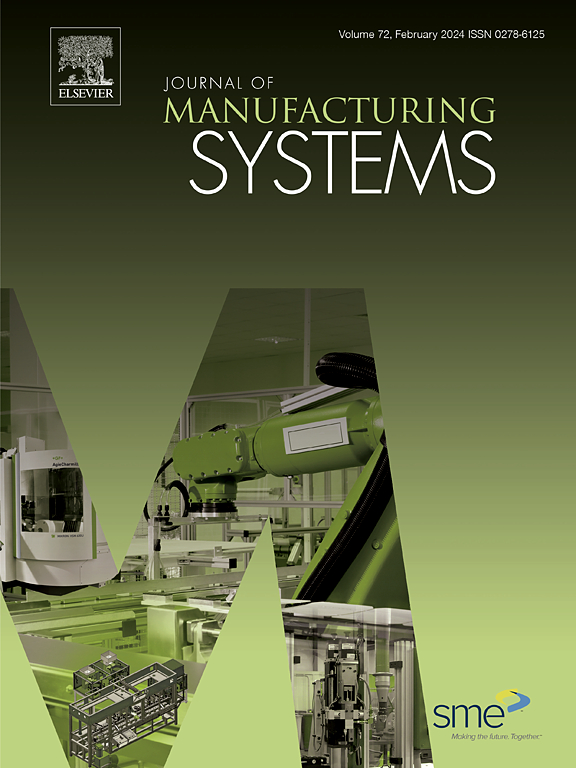制造业中刀具磨损和剩余使用寿命预测的物理信息符号回归
IF 14.2
1区 工程技术
Q1 ENGINEERING, INDUSTRIAL
引用次数: 0
摘要
预测与健康管理(PHM)在提高工程系统的可靠性和安全性方面起着至关重要的作用。最近,基于物理的机器学习(PIML)方法因其将特定领域知识整合到数据驱动模型中的能力而获得了极大的关注。本文提出了一种将符号回归与递归建模相结合的新方法,为动态过程的PHM开发了一个鲁棒的框架。我们的框架被应用到一个制造过程中,以建立一个通用模型,用于各种加工场景下的刀具磨损预测。该方法将不同条件下铣削过程的领域知识与递归模型相结合,利用符号回归实现准确、鲁棒的刀具磨损预测。考虑到传感器信号提取的特征与刀具磨损之间的强相关性,建立了递归特征模型和递归刀具磨损模型,以准确预测未来刀具磨损。采用基于遗传规划的物理系统识别工具箱(GPTIPS)进行符号回归。结果表明,所提出的框架可以通过使用新数据递归更新预测来捕捉工具磨损的动态,并可以推导出代表工具磨损过程物理特征的简单、可解释的数学表达式。基准分析证明了所提出方法的有效性,与文献中其他工具磨损预测模型相比,该方法的均方根误差(RMSE)更低。本文章由计算机程序翻译,如有差异,请以英文原文为准。
Physics-informed symbolic regression for tool wear and remaining useful life predictions in manufacturing
Prognostics and Health Management (PHM) plays a crucial role in enhancing the reliability and safety of engineering systems. Recently, physics-informed machine learning (PIML) methods have gained significant attention for their ability to incorporate domain-specific knowledge into data-driven models. This paper proposes a novel approach that integrates symbolic regression with recursive modeling to develop a robust framework for PHM of dynamic processes. Our framework was applied to a manufacturing process to build a generic model for tool wear prognostics across various machining scenarios. The proposed method integrates domain knowledge of milling processes under different conditions with recursive models using symbolic regression to achieve accurate and robust tool wear predictions. A recursive feature model and a recursive tool wear model were developedto accurately predict future tool wear, taking into consideration the strong correlation between features extracted from sensor signals and tool wear. The Genetic Programming-based Toolbox for Identification of Physical Systems (GPTIPS) was employed for symbolic regression. The results illustrate that the proposed framework can capture the dynamics of tool wear by recursively updating predictions with new data and can derive simple, interpretable mathematical expressions that represent the physical characteristics of the tool wear process. Benchmarking analysis demonstrated the effectiveness of the proposed approach, achieving lower root-mean-square error (RMSE) compared to other tool wear prognostic models in the literature.
求助全文
通过发布文献求助,成功后即可免费获取论文全文。
去求助
来源期刊

Journal of Manufacturing Systems
工程技术-工程:工业
CiteScore
23.30
自引率
13.20%
发文量
216
审稿时长
25 days
期刊介绍:
The Journal of Manufacturing Systems is dedicated to showcasing cutting-edge fundamental and applied research in manufacturing at the systems level. Encompassing products, equipment, people, information, control, and support functions, manufacturing systems play a pivotal role in the economical and competitive development, production, delivery, and total lifecycle of products, meeting market and societal needs.
With a commitment to publishing archival scholarly literature, the journal strives to advance the state of the art in manufacturing systems and foster innovation in crafting efficient, robust, and sustainable manufacturing systems. The focus extends from equipment-level considerations to the broader scope of the extended enterprise. The Journal welcomes research addressing challenges across various scales, including nano, micro, and macro-scale manufacturing, and spanning diverse sectors such as aerospace, automotive, energy, and medical device manufacturing.
 求助内容:
求助内容: 应助结果提醒方式:
应助结果提醒方式:


